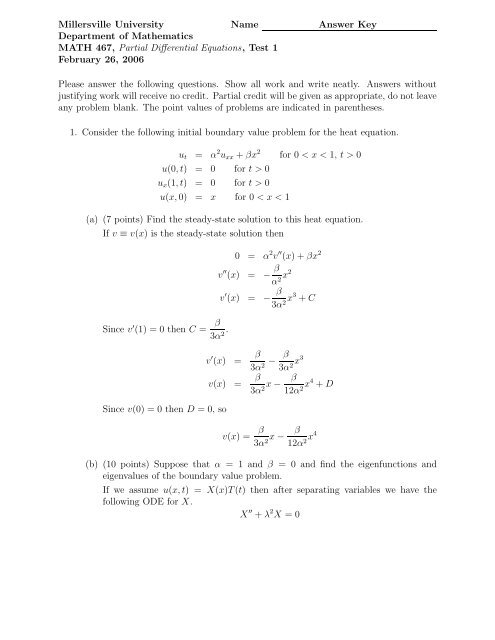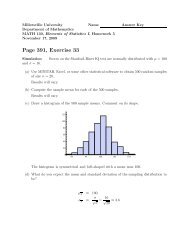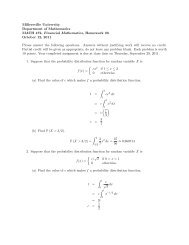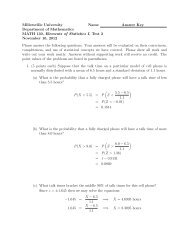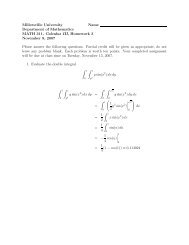Millersville University Name Answer Key Department of Mathematics ...
Millersville University Name Answer Key Department of Mathematics ...
Millersville University Name Answer Key Department of Mathematics ...
Create successful ePaper yourself
Turn your PDF publications into a flip-book with our unique Google optimized e-Paper software.
<strong>Millersville</strong> <strong>University</strong> <strong>Name</strong> <strong>Answer</strong> <strong>Key</strong><br />
<strong>Department</strong> <strong>of</strong> <strong>Mathematics</strong><br />
MATH 467, Partial Differential Equations, Test 1<br />
February 26, 2006<br />
Please answer the following questions. Show all work and write neatly. <strong>Answer</strong>s without<br />
justifying work will receive no credit. Partial credit will be given as appropriate, do not leave<br />
any problem blank. The point values <strong>of</strong> problems are indicated in parentheses.<br />
1. Consider the following initial boundary value problem for the heat equation.<br />
ut = α 2 uxx + βx 2<br />
u(0, t) = 0 for t > 0<br />
ux(1, t) = 0 for t > 0<br />
u(x, 0) = x for 0 < x < 1<br />
for 0 < x < 1, t > 0<br />
(a) (7 points) Find the steady-state solution to this heat equation.<br />
If v ≡ v(x) is the steady-state solution then<br />
Since v ′ (1) = 0 then C = β<br />
3α 2.<br />
Since v(0) = 0 then D = 0, so<br />
0 = α 2 v ′′ (x) + βx 2<br />
v ′′ (x) = − β<br />
α 2x2<br />
v ′ (x) = − β<br />
3α 2x3 + C<br />
v ′ (x) = β β<br />
−<br />
3α2 3α2x3 v(x) = β β<br />
3α2x −<br />
12α2x4 + D<br />
v(x) = β β<br />
3α2x −<br />
12α2x4 (b) (10 points) Suppose that α = 1 and β = 0 and find the eigenfunctions and<br />
eigenvalues <strong>of</strong> the boundary value problem.<br />
If we assume u(x, t) = X(x)T(t) then after separating variables we have the<br />
following ODE for X.<br />
X ′′ + λ 2 X = 0
If λ = 0 or if λ = iγ where i = √ −1 and γ ∈ R there are no solutions which<br />
satisfy the boundary conditions. Thus we may assume λ > 0. There are two<br />
linearly independent solutions to this ODE:<br />
X(x) = sin λx and X(x) = cosλx.<br />
Since cos(λ0) = 0 then we may ignore this solution.<br />
Since X ′ (1) = 0 then λ =<br />
for n ∈ N.<br />
X ′ (x) = d<br />
sin λx<br />
dx<br />
= λ cosλx<br />
X ′ (1) = λ cosλ<br />
(2n − 1)π<br />
2<br />
where n ∈ N. Thus we have<br />
Eigenvalues : λ 2 n = (2n − 1)2 π 2<br />
Eigenfunctions : Xn(x) = sin<br />
4<br />
(2n − 1)πx<br />
2<br />
(c) (13 points) Suppose that α = 1 and β = 0 and find the Fourier Series solution to<br />
the heat equation.<br />
The series form <strong>of</strong> the solution is<br />
where for n ∈ N,<br />
u(x, t) =<br />
∞<br />
n=1<br />
Ane −(2n−1)2π2t (2n − 1)πx<br />
4 sin ,<br />
2<br />
1<br />
An = 2<br />
(2n − 1)πx<br />
x sin dx<br />
0 2<br />
=<br />
8<br />
(2n − 1) 2 (2n − 1)π<br />
sin<br />
π2 2<br />
= 8(−1)n−1<br />
(2n − 1) 2 π 2.<br />
2. (5 points each) Consider the function<br />
<br />
sin x if −π ≤ x < 0,<br />
f(x) =<br />
1 − x/π if 0 ≤ x ≤ π.<br />
(a) Sketch the graph the sum <strong>of</strong> the Fourier series for f(x) for three complete periods.
1.0<br />
0.5<br />
5 5<br />
0.5<br />
1.0<br />
(b) Sketch the graph the sum <strong>of</strong> the Fourier sine series for f(x) for three complete<br />
periods.<br />
1.0<br />
0.5<br />
y<br />
5 5<br />
0.5<br />
1.0<br />
(c) Sketch the graph the sum <strong>of</strong> the Fourier cosine series for f(x) for three complete<br />
periods.<br />
1.0<br />
0.8<br />
0.6<br />
0.4<br />
0.2<br />
y<br />
y<br />
5 5<br />
x<br />
x<br />
x
3. (15 points) Consider the following initial boundary value problem for the wave equation<br />
with damping.<br />
utt + 2γut = c 2 uxx for 0 < x < L, t > 0<br />
u(0, t) = 0 = u(L, t) for t > 0<br />
u(x, 0) = f(x) for 0 < x < L<br />
ut(x, 0) = g(x) for 0 < x < L<br />
Assuming the solution u(x, t) has the form u(x, t) = X(x) T(t) use separation <strong>of</strong> variables<br />
to find the ordinary differential equations which X(x) and T(t) must satisfy. You<br />
do not need to find the solutions to these ordinary differential equations.<br />
If u(x, t) = X(x) T(t) then upon differentiating this solution and substituting into the<br />
damped wave equation we obtain<br />
X T ′′ + 2γX T ′ = c 2 X ′′ T<br />
X T ′′ + 2γX T ′<br />
c2X T<br />
= c2X ′′ T<br />
c2 T<br />
X T<br />
′′ + 2γT ′<br />
c 2 T<br />
= X′′<br />
X<br />
Since the left-hand side <strong>of</strong> this equation depends only on t and the right-hand side<br />
depends only on x they are both constant. If the constant is written as −λ 2 then the<br />
following two ODEs are implied.<br />
4. (10 points) The Fourier Series for<br />
is<br />
X ′′ + λ 2 X = 0<br />
T ′′ + 2γT ′ + λc 2 T = 0<br />
f(x) =<br />
f(x) ∼ 1<br />
2 +<br />
0 for −π < x < 0,<br />
1 for 0 ≤ x ≤ π,<br />
∞<br />
k=1<br />
2<br />
sin ((2k − 1)x) .<br />
(2k − 1)π<br />
Use these facts to find the sum <strong>of</strong> the following infinite series.<br />
∞<br />
k=1<br />
Note that f(x) is continuous at x = 1, thus<br />
f(1) = 1<br />
2 +<br />
∞<br />
k=1<br />
sin(2k − 1)<br />
2k − 1<br />
2<br />
sin ((2k − 1))<br />
(2k − 1)π
1 = 1 2<br />
+<br />
2 π<br />
k=1<br />
∞<br />
k=1<br />
1<br />
=<br />
2<br />
∞ 2 sin(2k − 1)<br />
π (2k − 1)<br />
k=1<br />
π<br />
4 =<br />
∞ sin(2k − 1)<br />
(2k − 1) .<br />
1<br />
sin ((2k − 1))<br />
(2k − 1)<br />
5. Consider the following initial boundary value problem for the wave equation.<br />
utt = uxx for 0 < x < 1, t > 0<br />
u(0, t) = 0 = u(1, t) for t > 0<br />
u(x, 0) = f(x) for 0 < x < 1<br />
ut(x, 0) = g(x) for 0 < x < 1<br />
(a) (10 points) Suppose f(x) = sin(2πx) and g(x) = 0. Find the solution to this<br />
initial boundary value problem (hint: d’Alembert’s solution).<br />
Functions f and g are both odd periodic functions <strong>of</strong> period 2 so d’Alembert’s<br />
solution is <strong>of</strong> the form<br />
x−t<br />
u(x, t) = 1<br />
1<br />
[f(x + t) + f(x − t)] + g(u) du<br />
2 2 x−t<br />
= 1<br />
[sin(2π(x + t)) + sin(2π(x − t))]<br />
2<br />
= 1<br />
[sin 2πx cos 2πt + cos 2πx sin 2πt + sin 2πx cos 2πt − cos 2πx sin 2πt]<br />
2<br />
= sin(2πx) cos(2πt)<br />
(b) (5 points) Sketch the solution to the wave equation found above for t = 1/3 on<br />
the axes provided below.<br />
u<br />
1.0<br />
0.5<br />
0.5<br />
1.0<br />
0.2 0.4 0.6 0.8 1.0 x
(c) (15 points) Suppose f(x) = 0 and g(x) = sin(πx). Find the solution to this initial<br />
boundary value problem (hint: d’Alembert’s solution).<br />
Functions f and g are both odd periodic functions <strong>of</strong> period 2 so d’Alembert’s<br />
solution is <strong>of</strong> the form<br />
u(x, t) = 1<br />
1<br />
[f(x + t) + f(x − t)] +<br />
2 2<br />
= 1<br />
2<br />
x+t<br />
x−t<br />
= − 1<br />
2π<br />
sin πu du<br />
cosπu| x+t<br />
x−t<br />
x−t<br />
x−t<br />
= − 1<br />
[cos(π(x + t)) − cos(π(x − t))]<br />
2π<br />
= 1<br />
[cos(π(x − t)) + cos(π(x + t))]<br />
2π<br />
<br />
g(u) du<br />
= 1<br />
[cosπx cosπt + sin πx sin πt + cosπx cos πt − sin πx sin πt]<br />
2π<br />
= 1<br />
cos(πx) cos(πt)<br />
π
Useful Formulas<br />
sin u sin v = 1<br />
[cos(u − v) − cos(u + v)]<br />
2<br />
sin u cos v = 1<br />
[sin(u + v) + sin(u − v)]<br />
2<br />
cos u cos v = 1<br />
[cos(u + v) + cos(u − v)]<br />
2


